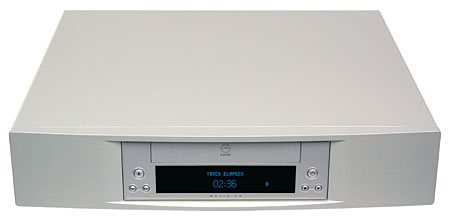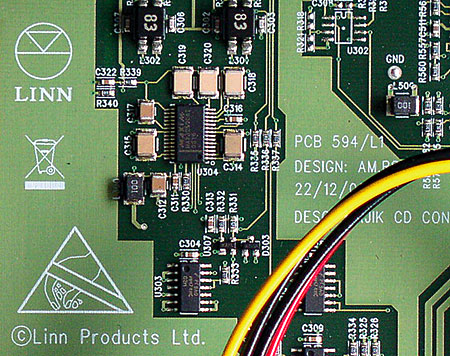| Columns Retired Columns & Blogs |
Linn Majik CD player
In the early 1980s, Ivor Tiefenbrun, of Linn Products, Ltd., compared digital audio to "a nasty disease" that his company offered not to spread. Less than 25 years later, digital sources outnumber analog ones in Linn's product line—so much so that the venerable Scottish manufacturer has expanded its line of disc players to encompass two different formats: multi- and two-channel.

The Majik CD player ($3500) is the first new member of the latter group. (It's also the only member, of any vintage: Linn was forced to discontinue its Sondek CD12 in 2004 because certain of its component parts were no longer available.) In fact, the Majik stands alongside the Majik Kontrol preamplifier ($3100) and Majik 2100 power amplifier ($2350) in a nascent line of products said to be designed specifically for music lovers. I can't help seeing proof of that claim in the Majik Kontrol's inclusion of a phono stage—that, and the fact that all three Majik components are designed to allow future upgrades, just like the you-know-what-12.
If all of that videolessness leaves you feeling out of step, bear in mind that the Majik components can be adapted for use within a Linn Knekt multiroom system. As they say in France: The more things stay the same, the more things change.
I forgot Poland
The Majik CD player's construction is unambiguously modern. Its metal chassis has a modular design, with a cutaway on the left-hand side and provisions for installing a presumably wide selection of front panels and double-sided circuit boards. Regarding the former, and apart from the fine print below its display, the Linn Majik CD is indistinguishable from the Linn Unidisk SC, which I reviewed in June 2005. Soft-touch buttons for the most basic controls straddle the digital display, and the aluminum-alloy faceplate as a whole conveys the same rich, sculpted look as the company's most expensive electronics. Considering the number of expensive products I've seen that have ill-fitting enclosures—surely I'm not the only reviewer who has removed the covers from certain amps and preamps only to find that the screws won't go back in the way they came out—I can't help being impressed by the level of engineering apparent in the Majik's metalwork.

Like virtually all modern disc players—and notwithstanding its noble two-channel mission—the Majik is built around a DVD transport: in this instance, the nearly ubiquitous DRL-210 from DVS. (As that company's website proclaims, "DVS Korea has new born to be the top of the world's DVD market." I couldn't agree more.) On a similar note, several onboard functions are handled by an ESS Technology DVD processor, the Vibratto [sic] S, presumably chosen for its compatibility with the MP3, HDCD, and DTS Audio formats. Beyond that, an abundance of SDRAM and FPGA chips suggests that Linn has decided to draw more on their own considerable software expertise than to rely on outside suppliers. The precise nature of the Majik's D/A conversion scheme is not published, apart from the fact that its sampling frequency is 44.1kHz. Perhaps John Atkinson's measurements will reveal more of the nature of the Majik CD's inner workings; sadly, the days when a glance inside a consumer-electronics product could give one a general understanding of its design—I'm thinking of the hallowed Quad II amplifier—are drawing to an end.
The Majik's power supply is the latest incarnation of Linn's proprietary Brilliant module, which I believe was the first switch-mode power supply developed specifically for perfectionist audio (and which has arguably found its highest calling in the Linn Linto phono preamplifier, whose low noise floor and complete lack of hum are unsurpassed in my experience). In a nutshell, this and other switching power supplies work by rectifying the incoming AC and then modulating it to a very high frequency—rather like a class-D amplifier—before rectifying and smoothing it once again. Thus they sidestep the need for very large transformers and reservoir capacitors, and all their trouble, noise, and expense.
My own reality
I used the Linn Majik CD player in my main system, listening at close range through a pair of Quad ESL loudspeakers, with various preamps and amps. Installation was straightforward: certainly more so than with the aforementioned Unidisk SC and its many output jacks.
Also in contrast to the Unidisk SC, one needn't connect the Majik to a video display in order to run its setup program. Strictly speaking, you don't have to run the setup program at all—but in my case it was worth doing, if only because it allowed me to compare the Majik's sound with and without a datastream present at its digital-out jack. The difference was slight—and quite possibly imagined. (I thought the player was marginally louder and cleaner with the output disarmed.) In any case, it cost nothing to try. I also used the Majik's setup procedure to increase its display brightness (which was supposed to have come from the factory at 100% and had not).
Four more words about that display: I didn't like it. Although the remote handset's Display button let me toggle through various display choices, the two pieces of information I most care about—track number and track time expired—were impossible to view at the same time. And, immediately after I'd loaded a disc and pressed Play, the readout wouldn't show track numbers when using the track-advance button to skip ahead: I had to count the clicks to know where I was. Who has that kind of concentration?
If I had to describe the performance of the Linn Majik in a very short space, I'd make the biggest deal about how clean it sounded—how open, pure, and unsmeared was its view of every note—while at the same time avoiding any suggestion of timbral flatness, lifelessness, or sterility. Recorded music had flesh and blood through the Majik; instrumental and vocal sounds had texture, presence, and all of the nearly indescribable cues that suggest differing levels of tension or stress in the playing or singing. But none of those qualities was overdone. The sound wasn't mushy or grainy; the player's character was neither chunky nor bright nor anything else undesirable. It was what it was: a very Old Testament sort of player.
Fritz Reiner and the Chicago Symphony's recording of Strauss's Sinfonia Domestica (RCA 68637-2) brought so many Linn strengths to the fore that I scarcely know where to begin. For all its cleanness, the Linn's spatial presentation was surprisingly big: not big and imprecise, but big and well defined. The believable tone of the oboe d'amore in the Scherzo (and beyond) reminded me that neutrality needn't bring with it a lack of richness and texture— shouldn't, in fact—and the Majik's clarity helped me follow the distinct threads of the Finale's double fugue, even after the strings came in.
- Log in or register to post comments



































